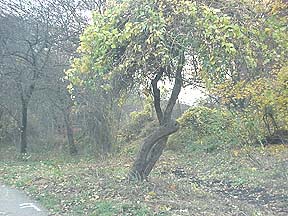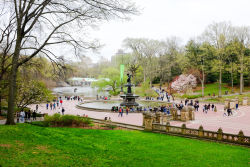Central Park
The Daily Plant : Wednesday, November 29, 2000
PARKS AND THE NEW YORK RESTORATION PROJECT

Photo by Tony (Archway) Arcamone
Porcelainberry, oriental bittersweet, wild grape, and japanese knotwood may appeal to the ear of an urban parkgoer, but they pose a serious danger to the health and beauty of Staten Island's Clove Lakes Park (1150 Clove Road, off Victory Blvd.), threatening to shade out shorter species and homogenize plant life. On Friday, November 17, Staten Island Parkies teamed up with the New York Restoration Project (NYRP) to root out the invaders-in all, 15 cubic yards of unwanted vines.
Supervisor of Park Maintenance Operations Mark (Python) Schultz and Associate Park Service Worker Keith Cavaliere worked beside 14 crew members from NYRP, an initiative begun by Bette Midler to restore the health of city parks. The team focused their efforts on the bridle path along the park's waterways. Free of thorns, the cleared trail will make a smoother, more pleasant ride.
NYRP crews, whose manpower and enthusiasm are the key to this effort's success, have agreed to return once a month for at least a year. Their work in Northern Manhattan was a great help, and this go-round promises to replicate the success. Deputy Chief of Operations, Lawrence (Inwood) Scoones commented on the helpfulness of the crew, "We only needed to point them to the starting location, and they really went to work; they brought their own tools and experienced supervisors." In exchange for their help, Parkies will instruct crew members in the proper pruning techniques for trees and shrubs.
KEEP A LOOK OUT FOR JAPANESE STILT GRASS, IT'S A THREAT TO NATIVE PLANTLIFE
Three years ago I couldn't find any, now it is common in natural areas of New York City Parks. The new invader, Japanese stilt grass (Microstegium vimineum) threatens to displace forest understory plants.
Originally from tropical Asia, stilt grass was first noted in the southern United States in 1919 and has been moving north ever since. It has replaced native forest and flood plain plants in New Jersey and neighboring states. This plant is listed as one of the "top twenty" invasive alien plants by the NYS Natural Heritage Program and the New York State Invasive Plant Council. It is also listed on their website at: http://www.nysm.nysed.gov/ipcnys/.
Stilt grass is an annual weed that sprouts from seeds in the soil. It germinates in early to mid June, before common crab-grass. It is bright yellow-green, with a thin, wiry, branching stem that tends to sprawl across the ground. It has short, wide leaves, 2-3 inches long. Stilt grass resembles white grass (Leersia virginica) but is loosely rooted and easy to pull up. It also tends to form long, thin "stilt" roots from the lower leaf nodes. It is shade tolerant and invades disturbed areas along forest trails and stream flood plains. Stilt grass grows very fast and can get up to three feet tall. It overtops and shades out low forest herbs, replacing them with a monoculture of stilt grass.
In just a couple of years, stilt grass can replace all the native plants in large patches of woodlands where the soil has been exposed. Each plant produces hundreds to thousands of seeds from late August until November. The seeds are small and easily transported by rainwater, shoes, dog's feet, birds or bike tires. Stilt grass seeds spend the winter in the soil and sprout in spring.
I have found Japanese stilt grass in several New York City Woodlands: Central Park North Woods, Alley Pond Park, Forest Park; Bloomingdale Park, Staten Island Greenbelt, Kingfisher Park, Long Pond Park, and Wolf's Pond Park. If you work in Parks' natural areas, you may be able to add to the list. I would be grateful for reports of stilt grass sightings, accompanied by samples (send by interoffice mail to: Arsenal North, Room 237). For more information, please call me at 212-360-1423.
Our best hope for controlling this plant is to educate people to recognize stilt grass and pull it up, roots and all, during the early summer before it goes to seed.
By Margaret B. Gargiullo, Ph.D., (Quercus), Natural Resources Group, Plant Ecologist
THIRTEEN YEARS AGO IN THE PLANT
(Wednesday, December 2, 1987)
EXHIBIT AT THE DAIRY: AN OASIS OF CULTURE
"Central Park: Oasis in the City" is the theme of Parks' free multi-media exhibit at the Dairy (mid-park and 64th Street) which opens to the public today for permanent display. Also to be unveiled as part of the Dairy's permanent archives is the new Central Park Reference Collection, the most complete record of the park available to the public. Featuring over 100 mostly out-of-print books, pamphlets and articles, the collection also includes annual reports from the Parks Department dating from 1857 to the present.
QUOTATION FOR THE DAY
"Pickaxe, shovel, spade, crowbar, hoe, and barrow, Better not invade, Yankees have the marrow."
Samuel Woodworth (1785-1842)
Check out your park's Vital Signs
Clean & Safe
Green & Resilient
Empowered & Engaged Users
Share your feedback or learn more about how this park is part of a
Vital Park System
Contacts
Central Park Information: (212) 310-6600
Central Park Information (for the Hearing Impaired): (800) 281-5722
Belvedere Castle, The Henry Luce Nature Observatory: (212) 772-0210
The Charles A. Dana Discovery Center: (212) 860-1370
The Dairy Visitor Center and Gift Shop: (212) 794-6564
North Meadow Recreation Center: (212) 348-4867
Loeb Boathouse (Bike rentals, boat rentals & gondolas): (212) 517-2233
Carousel: (212) 879-0244
Fishing at Harlem Meer (Catch & Release): (212) 860-1370
Harlem Meer Performance Festival: (212) 860-1370
Horseback Riding - Claremont Stables: (212) 724-5100
Metropolitan Opera (Performances on the Great Lawn): (212) 362-6000
New York Philharmonic (Performances on the Great Lawn): (212) 875-5709
Shakespeare in the Park - The Public Theater at the Delacorte Theater: (212) 539-8655
Central Park SummerStage: (212) 360-2777
Swedish Cottage Marionette Theater: (212) 988-9093
Tennis: (212) 280-0205
Weddings, Ceremonies and Photography at the Conservatory Garden: (212) 360-2766
Wildlife Center & Tisch Children's Zoo: (212) 439-6500











